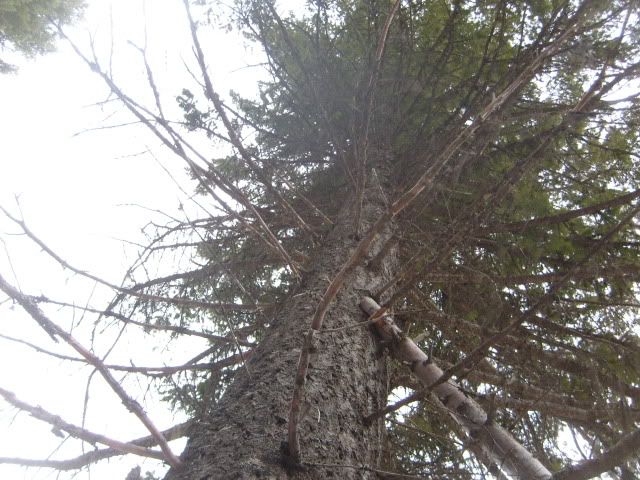-
Sorry for the long wait, I was waiting for some snow to melt, so I could dump some trees on my neighbor's property. Real easy trees to work with and photograph the process.
Firstly, when you pick the tree you wish to fall, it is best to identify the natural aspect of the tree and any potential hazards, with the tree or the surrounding. area.
For the natural aspect, you want to know what the natural lean is and the limb weight of the crown or top of the tree. These elements will determine the direction that the tree naturally want to fall. With coniferous trees, limbs will tend to grow on the side that receive sunlight the most, thereby leaving the opposite side of the tree somewhat barren, lower from the top you get.
In the following picture the target tree is dead center. Notice how the limbs are fuller and more developed on the left side (downhill) than the right, or uphill side. That is your limb weight. In the case of this tree, it will have no bearing as I intend to fall the tree downhill. At times I've had limbs on the opposite side of the tree, and contrary to the direction I wished to fall. Such an instance can be countered with the use of wedges, but be careful, the limb weight will sometimes cause the tree to spin on the stump as it is falling possibly endangering yourself.
As a rule of thumb, never try to fall a tree more than 45 degrees off from its natural lean.

As you approach the tree, you are going to look for potential hazards. First, look up into the top for widow makers, branches that may fall down on your head while cutting. Look for other trees leaning into your target tree. You need to remove those before you fall your target tree. Look at your intended falling direction for trees that will hinder the fall of your tree, or for loose branches in those trees. If your tree hits or glances off another tree, depending on the top of that tree, it will bend with your faller, but spring back like a sling shot, flinging loose material, or even the entire top back at you.
Next look at the intended fall path of your tree. Any dead logs on the ground may either be flung up like a teeter-totter, or cause your tree to bounce. Both situations are bad news for you. It's best to have you fall path clear of obstructions to facilitate smooth, soft landing.
Next check your target tree for anomalies such as frost cracks, lighting stripes, animal burrow holes, and hollowness. Each of these aspects could have a negative effect on how the tree responds while cutting it, possibly causing loss of life. To sound for hollowness, just whack the tree with a hatchet above, below, and at your intended cutting section. You will be able to tell when a tree is hollow in the core. If it is, skip it, and find another.

After all these safety precautions are taken, you can now engage in the falling process.
Tags for this Thread
 Posting Permissions
Posting Permissions
- You may not post new threads
- You may not post replies
- You may not post attachments
- You may not edit your posts
-
Forum Rules










 Reply With Quote
Reply With Quote

Bookmarks